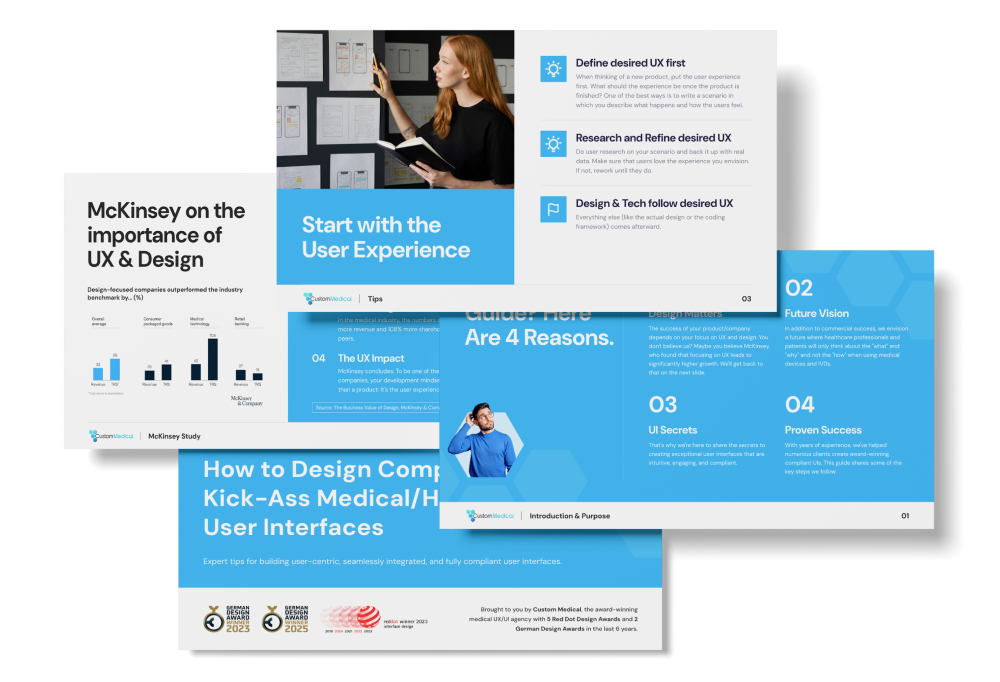When you start a medical UI/UX design project, you are often faced with many questions. One of them is the billing model:
- Do I want a fixed price?
- Is hourly billing right for me?
- What is a flat rate model?
In this article, we want to shed some light on the subject. We will compare all three models and emphasize possible advantages and disadvantages. After reading, you can decide which model is right for you.
To make this decision easier, we also offer a decision tree. You can find it at the end of this article.
1. Fixed price billing
What is the fixed price model?
With fixed price billing, the project team clearly defines the scope of work from the start. Each task and the desired result are specified. This makes it clear to both parties how the project will proceed and what the result will be.
The price is agreed on this basis. It only changes if the tasks change. Otherwise, a fixed price is just what it sounds like: fixed.
Note: With fixed price billing, you as the client pay for the result.
What are the advantages of fixed price billing?
- Budget certainty: One of the biggest benefits of the fixed price model is the predictability of costs. Since the price is agreed at the beginning of the project, there are no surprises along the way. This is especially beneficial for clients on a tight budget.
- Clear results: Thanks to the agreed project goal, the client and the agency have a clear understanding of what is to be delivered. This helps set expectations and reduces the likelihood of misunderstandings or disputes.
- Efficient time management: Because tasks are defined in advance, the project can be planned accurately. This allows both sides to agree on when each deliverable will be available.
What are the disadvantages of fixed price billing?
- Limited flexibility: The biggest disadvantage of the fixed price model is limited flexibility. If project goals change during the project, planning and negotiation is required. This typically changes the project plan and budget.
- Fixed prices are only possible with experience: When billing at a fixed price, the agency bears the price risk. Therefore, an agency may not want to offer a fixed price. This is usually the case when there is little experience in the specific area.
2. Billing by the hour
What is hourly billing?
In this model, hourly or daily rates are agreed upon for each activity. At the end of the billing period (typically one month), the hours worked are totaled and billed.
Hourly rates typically vary by seniority. For example, a senior UX designer will cost more than a junior UX designer. The activity can also make a difference. For example, creating a user interface concept might have a different hourly rate than visual design.
Note: With hourly billing, you as the client pay for the time spent on a specific activity.
What are the advantages of hourly billing?
- Increased flexibility: Unlike a fixed price project, an hourly project does not define the scope of work in the same level of detail. Therefore, the scope can change within certain limits – after all, the hours worked are billed.
- Increased flexibility part 2: Sometimes the perfect project workflow only emerges in detail during the project. For example, when a UX test reveals new insights. Billing by the hour gives you the flexibility you need.
What are the disadvantages of hourly billing?
- Unclear costs: The biggest problem with hourly billing is the lack of cost transparency. This can be addressed by providing hourly estimates for individual activities within an hourly project. However, the exact cost is not known until the invoice is issued.
- Higher level of expertise required on the client side: Billing based on seniority and activity can be difficult to monitor. Managing an hourly project typically requires a higher level of technical expertise.
- Flexibility has its limits: Changes during the project require coordination. It is not always possible to accommodate them in the time frame the client wants. As a result, projects can take longer.
How to Design Compliant Kick-Ass Medical/Health User Interfaces


3. Flat rate billing
What is flat rate billing?
Flat rate billing is where a fixed monthly amount is agreed upon and charged. Within that month, as many design tasks as desired can be submitted. The agency works on them according to the client’s priorities.
The monthly amount is usually based on the included activities and the number of designers used. For example, if two designers are working on the project at the same time, the amount will be higher than for a single designer.
Note: If you pay a flat rate, you pay for the number of designers and activities included. It is most similar to having an in-house design team (but without the personnel issues).
What are the advantages of paying a flat rate?
- Maximum flexibility: The agency promises that any included activity can be processed at any time. This gives you the flexibility to change and reprioritize tasks.
- Budget certainty: There can be no unplanned high bills, as the monthly amount is fixed.
- Easy coordination: The agency decides who is the best person for the job. This eliminates the need for design expertise on the client’s end and saves time on coordination.
What are the disadvantages of a flat rate?
- Time instead of results: As with an hourly project, you are (indirectly) buying time rather than results. This is where flat rates with dedicated account managers come in. These managers can keep an eye on the client’s desired outcome.
- Costs even without work: If no work is done for a while, the flat rate continues to run. Packages that allow for pausing can help here.
Conclusion & Decision Tree
Choosing the right billing model for your medical UI/UX design project depends on several factors. You should weigh them carefully:
The fixed price model offers budget certainty and a defined schedule. However, it also requires detailed and early planning, which allows for less flexibility during the project.
Hourly billing allows for a high degree of flexibility and adaptability as the project progresses. However, it carries the risk of unforeseen costs and requires more expertise on the part of the client.
Flat rate offers a combination of flexibility and budget certainty. However, it is only cost-effective if tasks are assigned on a regular basis.
Ultimately, the decision depends on how important plannability, budget control, and flexibility are to you over the course of the project. Here is our decision tree to help you make an initial assessment.
At our medical UX design agency, we understand that every project is unique. We work closely with our clients to choose the billing model that best suits their needs. That’s why we often use hybrid models.
Do you have a specific project or questions about our billing models? Contact us here and we will be happy to answer your questions.




